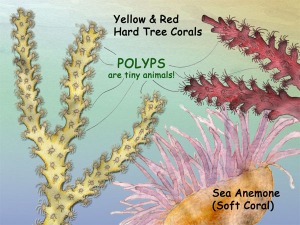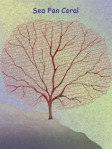What is a coral polyp?

Polyps are tiny animals. Hard tree corals exist in a variety of colors. The sea anemone is a soft coral.
A polyp is an animal. Most polyps are tiny and live in clusters called ‘colonies.’ Polyps may have hard or soft skeletons. Of the 2,400 living species of corals worldwide, two-thirds of the known coral species have soft skeletons, while one-third of the species have hard skeletons. The type of polyp determines the size and shape of the colony. Some colonies look like “trees” while another colony may look like a brain!

Hard coral polyps have tentacles, a mouth, throat, and stomach, but unlike soft polyps, the hard polyps also have a base made of limestone.
When polyps with hard skeletons die, their tiny bones create a rock called ‘limestone.’ Coral reefs are made of limestone or the crushed bones of many, many millions of hard polyps! Reef-building corals include: Mushroom Coral, Staghorn Coral, Brain Coral, Bubble Coral, Chalice or Lettace Coral, and Tree or Tube Coral.
Some polyps live alone. The Mushroom Coral is a large, single polyp.
Click on a question or link below to learn more about corals:
What is a coral polyp?






